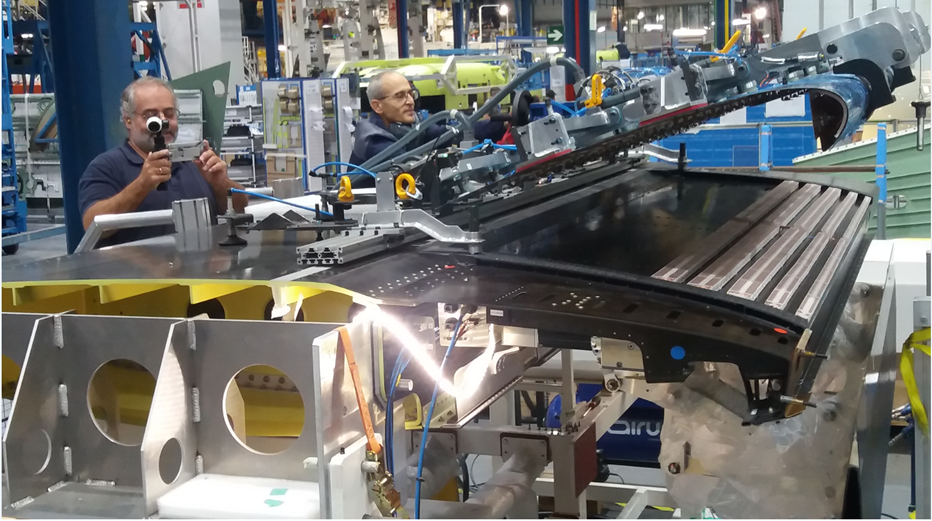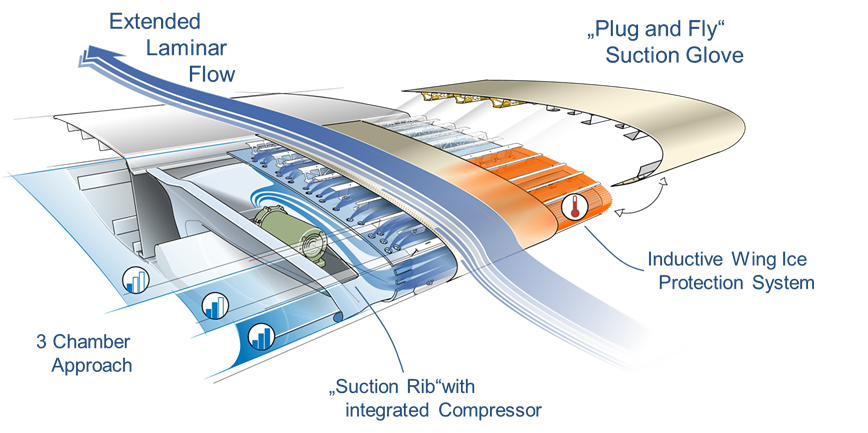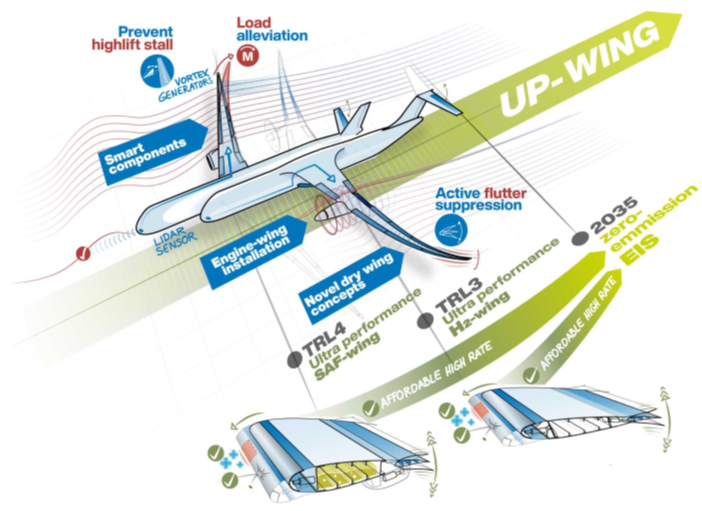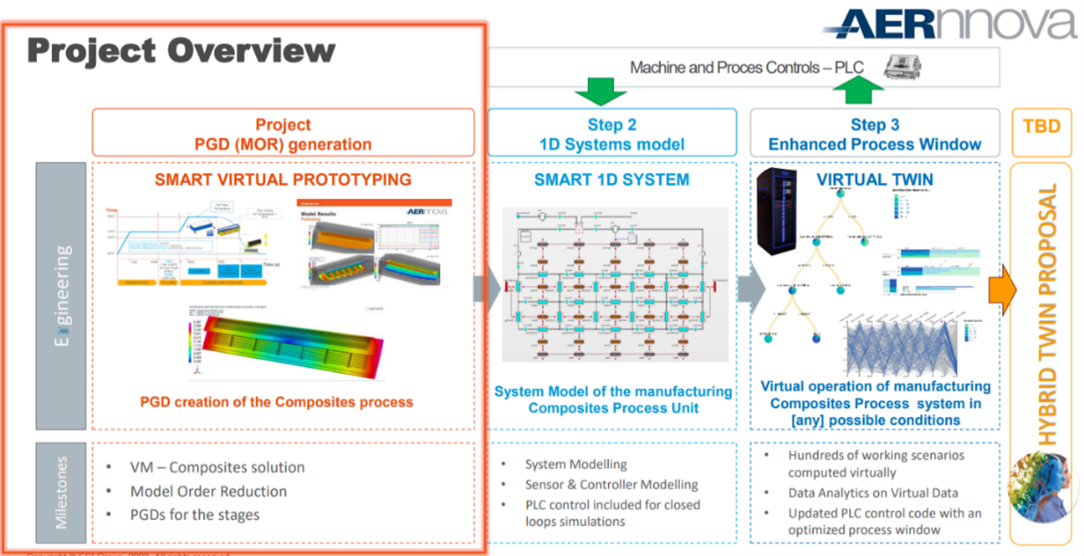Miguel Ángel Castillo – Director de Desarrollo Tecnológico
Federico Martín de la Escalera – Head of R&T AED Madrid
David Cruz Palacios Senior Design Engineer R&T
The future of aviation leads us to a growth marked by environmental responsibility, which includes, among others, (i) low carbon energy systems, (ii) aeronautical solutions with lower energy consumption with lighter and aerodynamically more efficient structures, (iii) aircraft with 100% low consumption electrical systems.
Aernnova collaborates in several main European projects and other transversal projects such as Clean Sky / Clean Aviation, e-Flight or LaserWay; developed over the last few years.
(i) Regarding new aeronautical configurations with lower energy consumption with lighter and aerodynamically more efficient structures, we are active in the development of solutions that integrate optimized aerodynamic developments such as Hybrid Laminar Flow Control (HLFC) or “morphing” structures aimed at reducing the aerodynamic drag generated by the aircraft’s external discontinuities in its maneuvers, in a reduced maintenance environment.
Within the HLFC (Hybrid Laminar Flow Control) project, current stabilizer leading edge structures were modified, and complete wing leading edge structures were designed integrating suction systems and their control, giving rise to two demonstrators, being the porosity or variable microperforation of the outer skin the cornerstone of the aerodynamic optimization of the laminar flow suction.
Within this project, Aernnova has obtained several patents for structural solutions for the development of modular systems for the integration of leading-edge skins and their suction system.
 Demostrador final (GBD) HLFC Win
Demostrador final (GBD) HLFC Win
 Demostrador final (GBD) HLFC Win
Demostrador final (GBD) HLFC Win
The LaserWay project is developing the next generation of industrial-strength variable micro-perforation laser equipment where the geometrical requirements for porosity quality at each point of the wing surface come directly from aerodynamic optimization. This knowledge is in addition to that already gained in the development of the HyperDrill, which is complementary to HLFC.
Throughout the UpWing project we collaborated in the design and manufacture of a deformable leading edge or “morphing – induced” in thermoplastic for high aspect ratio wings for new generation commercial transport aircraft, with the integration of a fully electrical anti-icing system that uses piezoelectric sensors to detect the formation of ice, and with these generates vibrations to break the ice formed on the leading edge.
The industrial challenge is that the use of thermoplastic allows a very high manufacturing rate of structures.
A third field of knowledge within this project is the development of non-conventional laminates, where the fibers are oriented following optimized paths in the most critical parts.
In addition, in the ENGRT project, funded by the EU, Aernnova is working with Airbus Helicópter and Leonardo on new helicopter platforms.
The HERA project aims to obtain metrics in production processes, such as measurement of electrical consumption to be evaluated in production lines both in autoclave and out of autoclave. In particular AED is developing a digital hybrid model of the manufacturing of a leading edge. The final result will be to be able to monitor in real time significant variables that impact the process, not only in terms of consumption, but also in terms of final quality, springback, etc. INEGI, an important Portuguese technology center based in Porto with which we are collaborating, is evaluating the possibility of energizing autoclave processes using solar energy. Airbus and Leonardo are focusing on out-of-autoclave processes, open to the use of composites based on thermosetting resins and thermoplastics.
(ii) The development of new low-carbon energy systems is an important pillar in terms of the drastic reduction of Cox emissions to the atmosphere. One of the current lines of development is the use of new fuels that offset emissions in their generation so that the net effect of their carbon footprint is zero or close to zero. Electrical energy stored in batteries or fuel cells powered by hydrogen or direct combustion of hydrogen. FASTER H2 is focused on liquid hydrogen as an energy system.
Here we face a technological challenge, the storage of liquid hydrogen at temperatures close to 250º C below zero.
The solution is the challenge and we are working on it.
Integrating technologies of composite and metallic materials that have the capacity to store hydrogen at these conditions of pressure and temperature, in addition to withstand the operating loads that justify the structural integrity, not only of the structural elements of storage, but also must demonstrate the distribution of fuel to reach the engines. We are working on this.
The following graph shows the use of hydrogen as a fuel, where the pressure and temperature variables are shown as a function of the energy density.
The left part of the graph clearly shows the technological challenge we are facing storage of liquid hydrogen at temperatures close to 250ºC below freezing. The solution is the challenge.
Integrating technologies of composite and metallic materials that have the capacity to store hydrogen at these conditions of pressure and temperature, in addition to withstand the operating loads that justify the structural integrity, not only of the structural elements of storage, it must also demonstrate the distribution of fuel to reach the engines.
Diagram Energy density of hydrogen as a fuel, associated with its state and temperature. Liquid hydrogen at 4 bar pressure at 33 K is the equilibrium point as fuel for an aircraft.
Type IV tanks are manufactured with an external jacket that provides the resistant function in composite material (usually carbon fiber) and an internal jacket that provides the gas barrier function (usually made of injected thermoplastic or rotomolded). On the other hand, type V tanks are manufactured with a single composite liner that combines both functions, resistant and barrier.
The most common manufacturing processes for these tanks are “filament winding” (with wet wire) or “automatic fiber placement”, both of which require a subsequent autoclave curing process. In collaboration with technological partners, we are working on alternative non-autoclave processes.
(iii) Finally, the third of the areas in which Aernnova is working to achieve a growth in aviation marked by environmental responsibility is the use of 100% electric systems. In our article on new mobility, you will see Aernnova’s projects related to this area.








